Dashboards
This feature is in Early Access
LaunchDarkly’s observability features are publicly available in early access. Enable observability in the billing page.
They currently require the LaunchDarkly observability SDKs and the JavaScript, React Web, or Vue SDK.
If you are interested in participating in the Early Access Program for our upcoming observability plugins for server-side SDKs, sign up here.
Overview
This topic explains how to use dashboards in LaunchDarkly observability.
Dashboards let you visualize what’s happening in your app. They can show error rates, APM trends, user engagement, and more. Dashboards are comprised of graphs, which are visualizations of data that you can create and configure to show the data you want.
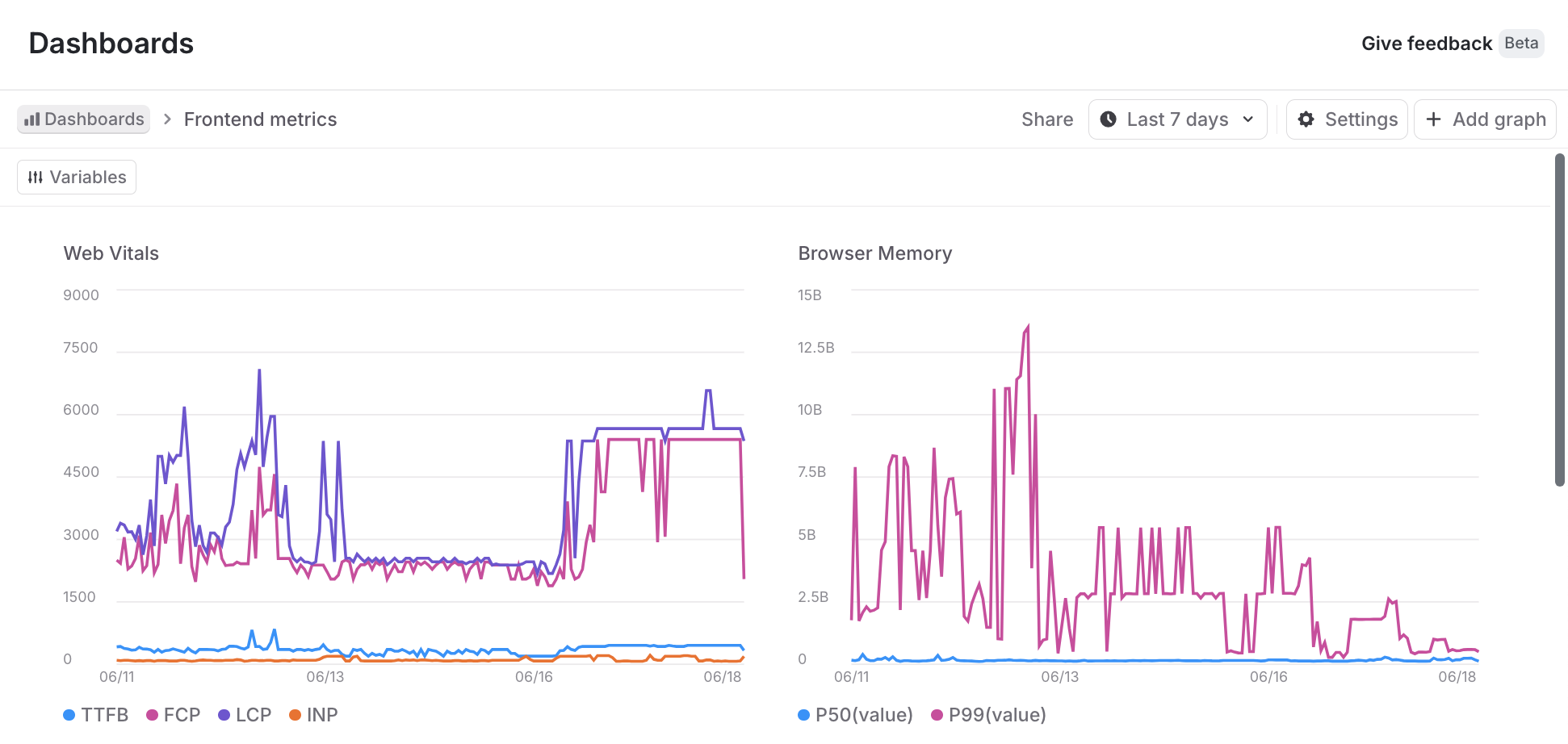
Create a dashboard
Here’s how to create a dashboard:
- In the LaunchDarkly UI, click Dashboards in the left sidenav.
- Click Create new dashboard.
- Give your dashboard a human-readable Name.
- Click the dropdown to choose the Dashboard type:
- A Blank dashboard is initially empty. Use the Add graphs to a dashboard procedure, below, to populate it.
- A Frontend metrics dashboard is configured to include graphs for web vitals, browser memory, HTTP response size, HTTP request size, HTTP errors, and HTTP request latency.
- Click Create.
The new dashboard appears. For each Dashboard type, you can customize or remove graphs, and add additional graphs, to meet your reporting needs.
Add graphs to a dashboard
You can add graphs to a dashboard to visualize different data.
First, name the graph and specify how you want the data to display. Here’s how:
- In a dashboard, click + Add graph. The “New graph” page appears.
- Give your graph a human-readable Graph title.
- Choose the “View type” to specify how you want the graph to display data. The options are a line chart, a bar chart / histogram, or a table.
- (Optional) Select how to stack visualizations, which lets you compare amounts from multiple sources.
- For line charts, click Stack area to display multiple areas stacked on top of each other.
- For bar charts, click Stack bars to display multiple bars stacked on top of each other.
- (Optional) Specify how to handle Nulls or empty values. For line charts, nulls can be graphed as hidden, connected, or zero. For tables, nulls can be displayed as hidden, blank, or zero.
- Hidden means nulls are not displayed.
- Connected means if two non-empty values have empty or null values between them, the two non-empty values are graphed with a connecting line.
- Blank means nulls are displayed as blank rows in a table.
- Zero means nulls or empty values are displayed as having a zero value.
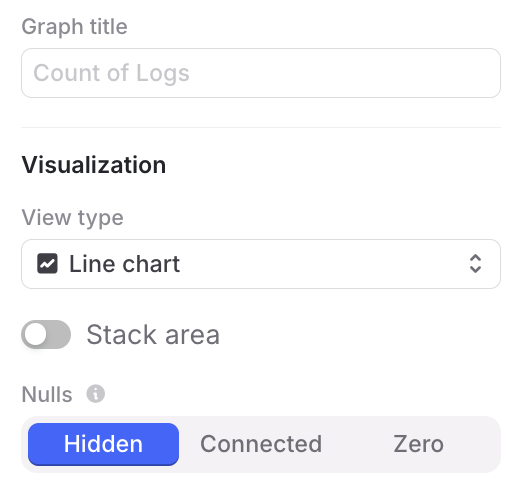
Next, build a query to populate the graph with data. Here’s how:
- Select how to build a query:
- Choose Query Builder to use the graph editor UI to query the data for your graph.
- Choose SQL Editor to write a custom query with SQL. If you use this option, disregard steps 2 though 5. After you write a query, click Run query. To learn more, read SQL Editor, below.
- Choose a Source from the dropdown. You can populate each graph with data from sessions, errors, logs, or traces.
- (Optional) Enter Filters to select which data points to include in your graph. For example, if you only want to include data from the production environment, set the
environmentfilter. To learn more about the filter syntax, read Search specification. - (Optional) Select a Function from the dropdown to determine how data points are aggregated. “Count” is selected by default. If you choose a function, such as “Min,” that requires a parameter, select the attribute to use as well.
- (Optional) To add an additional function, click Add function.
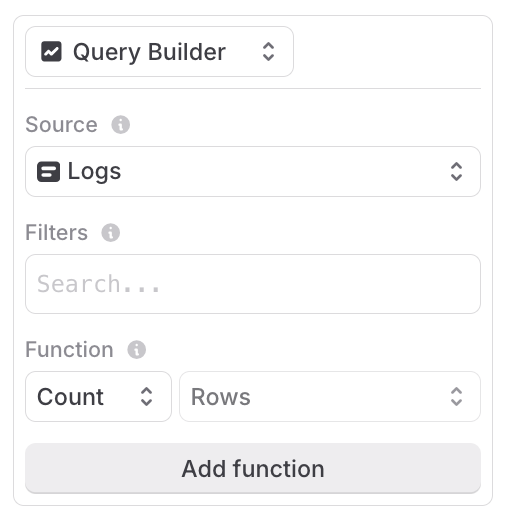
Then, choose options to group the data. Here’s how:
- (Optional) Enable the Group by toggle to group your query results into separate series. Use the dropdown to choose the category by which to group results. For example, you might group your logs by level.
- (Optional) Specify a Limit to restrict the number of groups displayed, and a function type by which to determine if a group should be included in the graph.
- (Optional) Toggle Bucket by to use buckets in your graph. Then select Interval or Count to indicate how bucket sizes should be determined.
- Bucketing by interval requires that you set a Bucket interval. A higher value displays more granular buckets.
- Bucketing by count requires that you set a Bucket field and number of Buckets to group by.
- For example, you might choose to bucket by Count with a Bucket field of “Timestamp” if you want to aggregate data points within consecutive time ranges. Or you might choose to bucket by Count with a Bucket field of “duration” if you want to examine the distribution of latency for a particular API endpoint. Or you might toggle Bucket by off to disable bucketing and aggregate data across your entire time range.
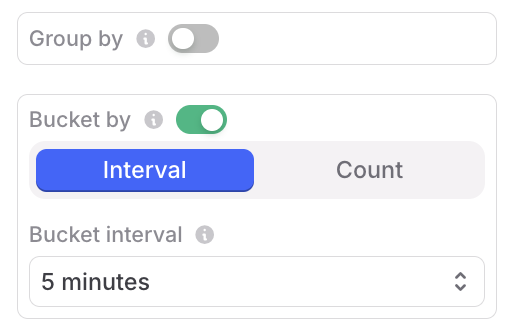
Finally, click Save. The new graph appears in the dashboard.
Advanced graph creation tools
The graph editor provides two advanced graph creation tools: the SQL Editor, which you can use to query data for your graph, and dashboard variables, which you can use to parameterize graphs.
SQL Editor
The SQL editor lets you write custom queries to retrieve your data and aggregate as you wish. Using the SQL editor is an alternative to using the graphical query builder.
Expand Use SQL Editor to retrieve graph data
When you are creating or updating a graph for your dashboard, you can choose SQL editor to write a custom query with SQL.
The SQL editor includes the following features and limitations:
-
The SQL editor supports the ClickHouse SQL dialect. To learn more, read the ClickHouse documentation.
-
The built-in macro
$time_interval(<duration>)expands totoStartOfInterval(Timestamp, <duration>). You can use this macro to group results by their timestamp, which makes time series queries easier to write. Here’s an example that returns a count of logs for every hour:Example using $time_interval macro -
The dashboard’s data range is automatically applied as a filter to all SQL queries. For example, if your graph uses
SELECT count() from logsand your dashboard’s filter isLast 4 hours, your resulting graph will only include logs within the last four hours. If you use aWHEREclause, it will filter in addition to the dashboard’s date range filter, and it will not include results outside that range. -
The SQL editor only supports a single
SELECTquery. However, you can include multiple select expressions. This displays multiple series on your graph. Here’s an example that returns an hourly count and average duration of all traces:Example querying multiple series -
LaunchDarkly stores custom fields and metadata without any type information. You should convert this data to the appropriate type in your SQL queries. Here’s an example where your application records a custom integer field to record how many items are in an end user’s shopping cart:
Example applying type conversion -
You can use aliases in your SQL queries so that your data is graphed with custom labels. Here’s an example:
Example using alias to create custom labels
Dashboard variables
Dashboard variables let you parameterize filters, bucketing, and grouping across multiple graphs. This makes it easier to make changes to sets of graphs at one time. After you create a dashboard variable, you can reference it in any of the filter, function, grouping, or bucketing rules components of the graph editor.
Expand Use dashboard variables in your graphs
You can create and edit dashboard variables from the dashboard or from the edit page for any graph.
Here’s how:
-
From the dashboard or the edit page of a graph, click Variables. The “Variables” dialog appears.
-
Click + New variable.
-
Enter a Name for the variable.
-
Select a Suggestion type for the variable. The following table describes the options:

The "Variables" dialog, with a new variable filled in. -
Click Save.
-
In any of the filter, function, grouping, or bucketing rules components of the graph editor, reference your variable by entering a dollar (
$) followed by the variable’s Name, for example,$environmentor$emailAddress.
View graph details
For each graph, you can always take a closer look at the underlying data. Here’s how:
-
Click Dashboards in the left sidenav.
-
Find the dashboard you want to update and click its name.
-
Find the graph you want to examine and hover over its graphed data. A tooltip of the current datapoints appears.
-
Click to freeze the tooltip and show links to the details for each data point:
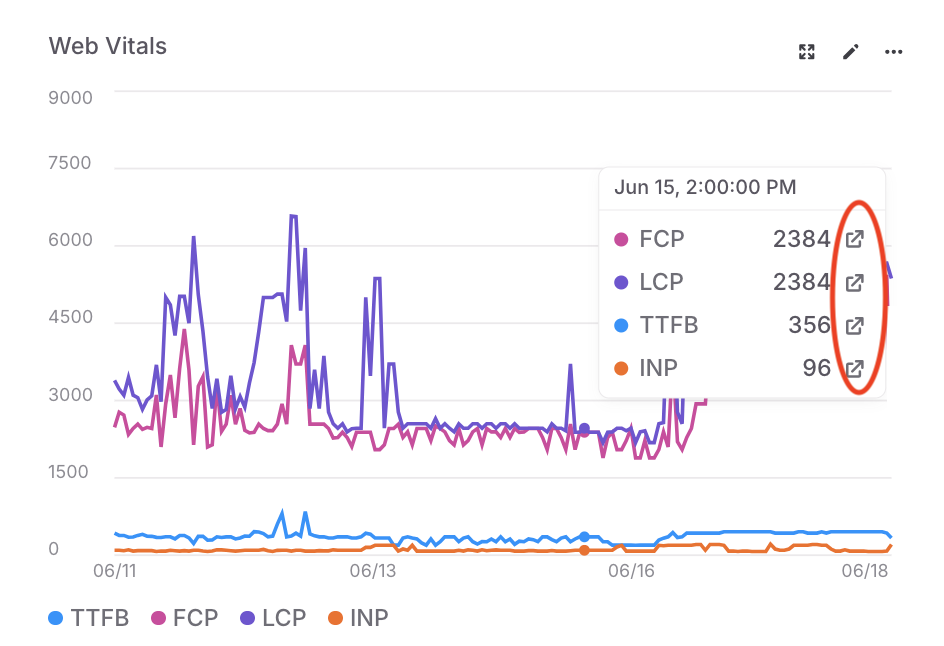
A graph on a dashboard. The tooltip displays information on the current datapoints, and the details links are called out. -
Click any of the details links to open a panel with the relevant sessions, errors, logs, or traces. The data points in the panel are filtered using the graph’s filters and the grouping, time range, or metric bucket for the specific data point that you selected.
From the detail panel, you can:
- Search the underlying data using the search specification for the LaunchDarkly observability features.
- Click Copy link and share the data with other members of your organization.
- Click a data row to review additional details.
Manage dashboards
After you create a dashboard, you can review, update, and share it. You can also add additional graphs or make changes to existing graphs.
Share a dashboard
To share a dashboard, click Dashboards in the left sidenav. Find the dashboard you want to update and click its name. From here, you can share the dashboard’s data in the following ways:
- To share a link to the dashboard, click Share. The URL for the dashboard is copied to your clipboard.
- To share the data behind a particular graph, find the graph and hover on its name. Click the overflow menu and choose “Download CSV.”
Update a dashboard
To update a dashboard, click Dashboards in the left sidenav. Find the dashboard you want to update and click its name. From here, you can make the following updates:
- To update the dashboard’s name or default time range, click Settings. Make the changes in the “Dashboard settings” dialog. Then click Save.
- To add a new graph, follow the Add graphs to a dashboard procedure, above.
- To clone an existing graph, find the graph you want to remove and hover on its name. Click the overflow menu and choose “Clone graph.”
- To remove a graph, find the graph you want to remove and hover on its name. Click the overflow menu and choose “Delete graph.”
- To update a graph, find the graph you want to remove and hover on its name. Click the pencil icon to edit the graph. For more information on the fields you can change in the graph setup, read the Add graphs to a dashboard procedure, above.
Delete a dashboard
To delete a dashboard:
- Click Dashboards in the left sidenav.
- Find the dashboard you want to delete.
- Click the overflow menu.
- Select Delete dashboard.
Deleted dashboards cannot be restored.
Deleted dashboards cannot be recovered
If you delete a dashboard, you cannot restore it. Be absolutely certain you do not need the dashboard before you delete it.